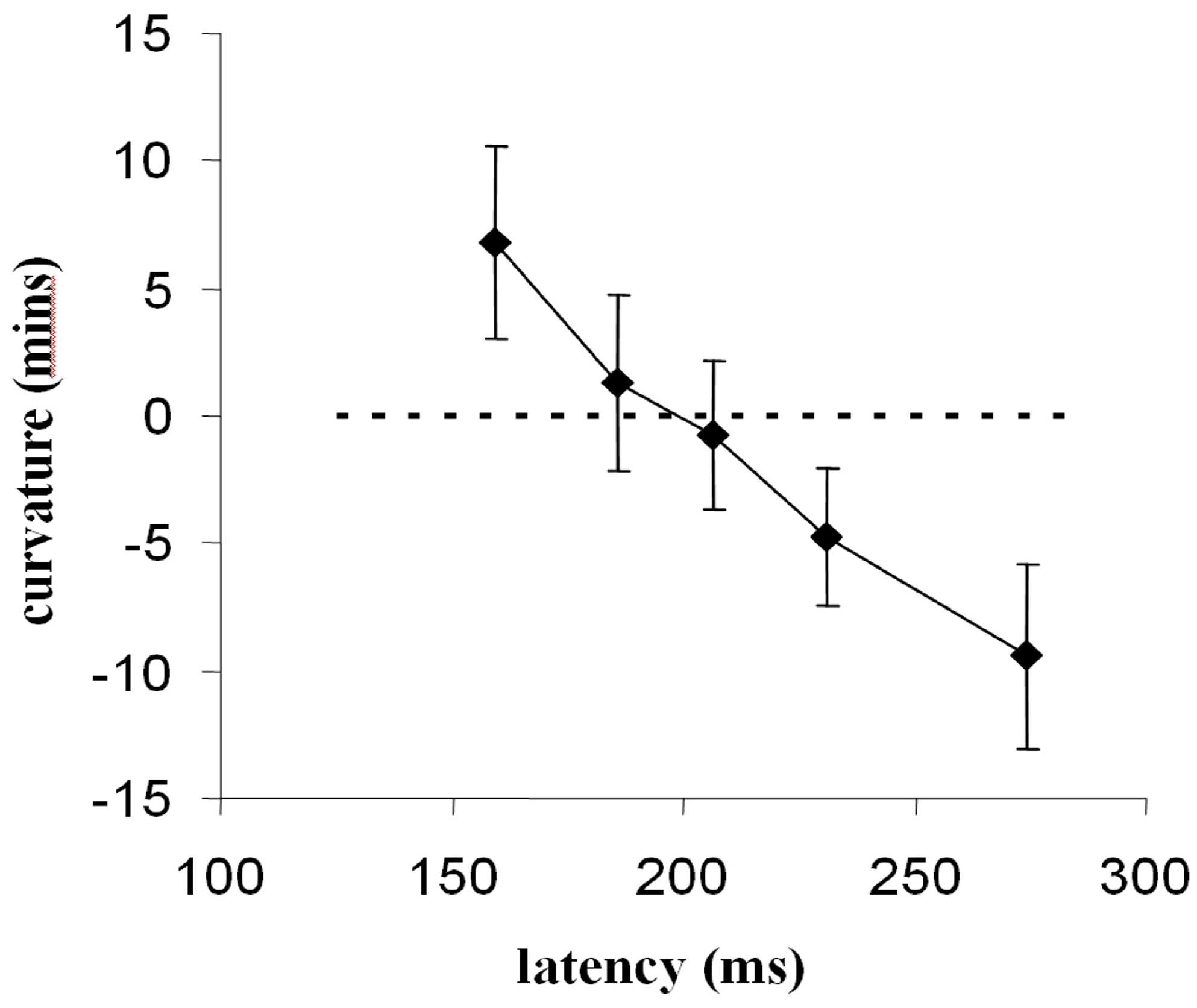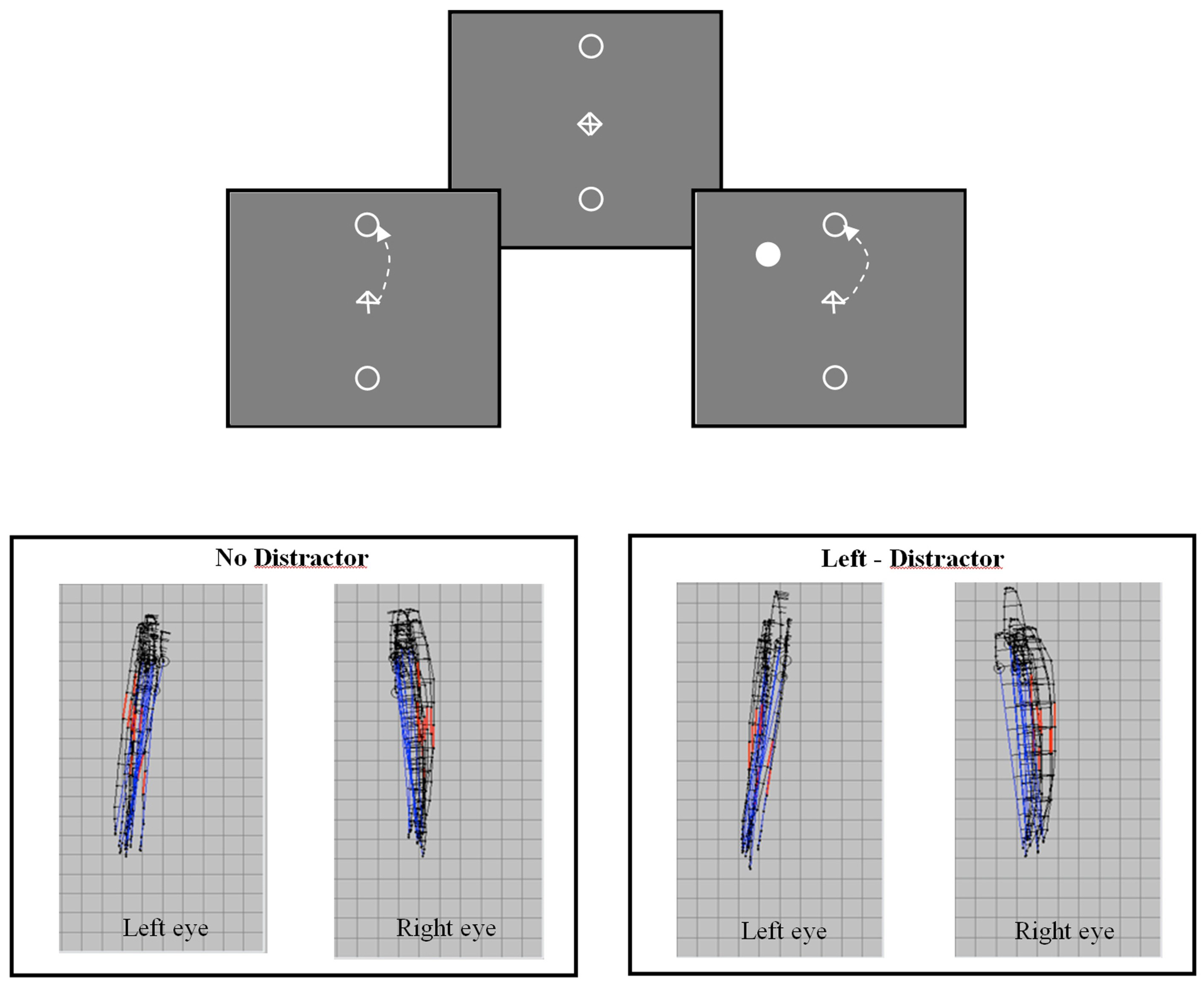The Influence of Distractors on Saccade-Target Selection: Saccade Trajectory Effects
Abstract
Introduction
Explanation of distractor effects
Spatial-effects
What mediates deviation towards or away from a location?
Predictable target locations
Relationship between trajectory deviation and saccade latency

Stimulation of the frontal eye fields using Transcranial magnetic stimulation
Summary
Acknowledgments
References
- Aizawa, H., and R. H. Wurtz. 1998. Reversible inactivation of monkey superior colliculus. I. Curvature of saccadic trajectory. Journal of Neurophysiology 79: 2082–2096. [Google Scholar]
- Collewijin, H., C. J. Erkelens, and R. M. Steinman. 1988. Binocular co-ordination of human vertical saccadic eye movements. Journal of Physiology 404: 183–197. [Google Scholar]
- Doyle, M., and R. Walker. 2001. Curved saccade trajectories: Voluntary and reflexive saccades curve away from irrelevant distractors. Experimental Brain Research 139: 333–344. [Google Scholar]
- Doyle, M., and R. Walker. 2002. Multisensory interactions in saccade target selection: curved saccade trajectories. Experimental Brain Research 142: 116–130. [Google Scholar]
- Godijn, R., and J. Theeuwes. 2004. The relationship between inhibition of return and saccade trajectory deviations. Journal of Experimental Psychology: Human Perception and Performance 30: 538–554. [Google Scholar]
- Groh, J. M., and D. L. Sparks. 1996a. Saccades to somatosensory targets I. Behavioral Characteristics. Journal of Neurophysiology 75, 1: 412–427. [Google Scholar] [PubMed]
- Groh, J. M., and D. L. Sparks. 1996b. Saccades to somatosensory targets II. Motor convergence in primate superior colliculus. Journal of Neurophysiology 75, 1: 428–438. [Google Scholar] [PubMed]
- Grosbras, M. H., and T. Paus. 2002. Transcranial magnetic stimulation of the human frontal eye field: Effects on visual perception and attention. Journal of Cognitive Neuroscience 14, 7: 1109–1120. [Google Scholar]
- Grosbras, M. H., and T. Paus. 2003. Transcranial magnetic stimulation of the human frontal eye field facilitates visual awareness. European Journal of Neuroscience 18, 11: 3121–3126. [Google Scholar]
- Kapoula, Z., M. Vernet, Q. Yang, and M. P. Bucci. 2008. Binocular coordination of saccades: development, aging and cerebral substrates. Journal of Eye Movement Research 2, 3: 1–19. [Google Scholar]
- Lee, C., W. H. Rohrer, and D. L. Sparks. 1988. Population coding of saccadic eye movements by neurons in the superior colliculus. Nature 332, March: 357–360. [Google Scholar] [PubMed]
- Leff, A. P., S. K. Scott, J. C. Rothwell, and R. J. S. Wise. 2001. The planning and guiding of reading saccades: a repetitive transcranial magnetic stimulation study. Cerebral Cortex 11, 10: 918–923. [Google Scholar] [PubMed]
- Ludwig, C. J. H., and I. D. Gilchrist. 2003. Target similarity affects saccade curvature away from irrelevant onsets. Experimental Brain Research 152: 60–69. [Google Scholar]
- Ludwig, C. J. H., and I. G. Gilchrist. 2002. Measuring saccade curvature: A curve fitting approach. Bevavior Research Methods, Instruments and Computers 34, 4: 618–624. [Google Scholar]
- McIlwain, J. T. 1991. Distributed spatial coding in the superior colliculus: a review. Visual Neuroscience 6: 3–13. [Google Scholar] [CrossRef]
- McPeek, R. M. 2006. Incomplete suppression of distractor-related activity in the frontal eye field results in curved saccades. Journal of Neurophysiology 96, 5: 2699–2711. [Google Scholar]
- McPeek, R. M., J. H. Han, and E. L. Keller. 2003. Competition between saccade goals in the superior colliculus produces saccade curvature. Journal of Neurophysiology 89, 5: 2577–2590. [Google Scholar]
- McPeek, R. M., and E. L. Keller. 2001. Short-term priming, concurrent processing, and saccade curvature during a target selection task in the monkey. Vision Research 41: 785–800. [Google Scholar]
- McSorley, E., P. Haggard, and R. Walker. 2004. Distractor modulation of saccade trajectories: spatial separation and symmetry effects. Experimental Brain Research 155: 320–333. [Google Scholar]
- McSorley, E., P. Haggard, and R. Walker. 2005. Spatial and temporal aspects of oculomotor inhibition as revealed by saccade trajectories. Vision Research 48: 2492–2499. [Google Scholar]
- McSorley, E., P. Haggard, and R. Walker. 2006. Timecourse of oculomotor inhibition revealed by saccade trajectory modulation. Journal of Neurophysiology 96, 3: 1420–1424. [Google Scholar] [PubMed]
- Munoz, D. P., and R. H. Wurtz. 1995. Saccade-related activity in monkey superior colliculus 2. Spread of activity during saccades. Journal of Neurophysiology 73, 6: 2334–2348. [Google Scholar] [PubMed]
- Muri, R. M., C. W. Hess, and O. Meienberg. 1991. Transcranial Stimulation of the Human Frontal Eye Field by Magnetic Pulses. Experimental Brain Research 86, 1: 219–223. [Google Scholar]
- Nummenmaa, L., and J. K. Hietanen. 2006. Gaze distractors influence saccadic curvature: Evidence for the role of the oculomotor system in gaze-cued orienting. Vision Research 46, 21: 3674–3680. [Google Scholar]
- O’Shea, J., N. G. Muggleton, A. Cowey, and V. Walsh. 2006. On the roles of the human frontal eye fields and parietal cortex in visual search. Visual Cognition 14: 934–957. [Google Scholar] [CrossRef]
- O’Shea, J., and V. Walsh. 2007. Transcranial magnetic stimulation. Current Biology 17, 6: R196–R199. [Google Scholar] [CrossRef] [PubMed][Green Version]
- Port, N. L., and R. H. Wurtz. 2003. Sequential activity of simultaneously recorded neurons in the superior colliculus during curved saccades. Journal of Neurophysiology 90: 1887–1903. [Google Scholar]
- Quaia, C., H. Aizawa, L. M. Optican, and R. H. Wurtz. 1998. Reversible inactivation of monkey superior colliculus. II. maps of saccadic deficits. Journal of Neurophysiology 79, 4: 2097–2110. [Google Scholar]
- Quaia, C., P. Lefévre, and L. M. Optican. 1999. Model of the control of saccades by superior colliculus and cerebellum. Journal of Neurophysiology 82: 999–1018. [Google Scholar] [CrossRef]
- Rizzolatti, G., L. Riggio, and B. M. Sheliga. 1994. Edited by C. Umiltà and M. Moscovitch. Space and selective attention. In Attention and performance XV. MIT press: pp. 231–265. [Google Scholar]
- Ro, T., S. Cheifet, H. Ingle, R. Shoup, and R. Rafal. 1999. Localization of the human frontal eye fields and motor hand area with transcranial magnetic stimulation and magnetic resonance imaging. Neuropsychologia 37, 2: 225–231. [Google Scholar]
- Ro, T., A. Farne, and E. Chang. 2002. Locating the human frontal eye fields with transcranial magnetic stimulation. Journal of Clinical and Experimental Neuropsychology 24, 7: 930–940. [Google Scholar] [PubMed]
- Saslow, M. G. 1967. Effects of components of displacement-step stimuli upon latency for saccadic eye movement. Journal of the Optical Society of America 57, 8: 1024–1029. [Google Scholar]
- Schlag-Rey, M., J. Schlag, and P. Dassonville. 1992. How the frontal eye field can impose a saccade goal on superior colliculus neurons. Journal of Neurophysiology 67, 4: 1003–1005. [Google Scholar]
- Sheliga, B. M., L. Riggio, L. Craighero, and G. Rizzolatti. 1995. Spatial attention-determined modifications in saccade trajectories. NeuroReport 6: 585–588. [Google Scholar]
- Sheliga, B. M., L. Riggio, and G. Rizzolatti. 1994. Orienting of attention and eye movements. Experimental Brain Research 98: 507–522. [Google Scholar] [PubMed]
- Sheliga, B. M., L. Riggio, and G. Rizzolatti. 1995. Spatial attention and eye movements. Experimental Brain Research 105: 261–275. [Google Scholar] [PubMed]
- Sparks, D. L., and R. Hartwich-Young. 1989. Edited by R. H. Wurtz and M. E. Goldberg. The deep layers of the superior colliculus. In The Neurobiology of Saccadic Eye Movements. Elsevier Science Publishers B.V.: pp. 213–255. [Google Scholar]
- Tipper, S. P., L. A. Howard, and G. Houghton. 2000. Edited by S. Monsell and J. Driver. Behavioural consequences of selection from neural population codes. In Control of cognitive processes: Attention and Performance XVIII. MIT press. [Google Scholar]
- Tipper, S. P., L. A. Howard, and M. A. Paul. 2001. Reaching affects saccade trajectories. Experimental Brain Research 136: 241–249. [Google Scholar]
- Van der Stigchel, S., M. Meeter, and J. Theeuwes. 2006. Eye movement trajectories and what they tell us. Neuroscience & Biobehavioral Reviews 30, 5: 666–679. [Google Scholar]
- Van der Stigchel, S., M. Meeter, and J. Theeuwes. 2007a. The spatial coding of the inhibition evoked by distractors. Vision Research 47, 2: 210–218. [Google Scholar]
- Van der Stigchel, S., M. Meeter, and J. Theeuwes. 2007b. Top-down influences make saccades deviate away: The case of endogenous cues. Acta Psychologica 125, 3: 279–290. [Google Scholar]
- Van der Stigchel, S., and J. Theeuwes. 2005. Relation between saccade trajectories and spatial distractor locations. Cognitive Brain Research 25, 2: 579–582. [Google Scholar] [PubMed]
- Van der Stigchel, S., and J. Theeuwes. 2006a. Our eyes deviate away from a location where a distractor is expected to appear. Experimental Brain Research 169: 338–349. [Google Scholar] [PubMed]
- Van der Stigchel, S., and J. Theeuwes. 2006b. Relation between saccade trajectories and spatial distractor locations. Cognitive Brain Research 25: 579–582. [Google Scholar]
- van Zoest, W., S. Van der Stigchel, and J. J. S. Barton. 2008. Distractor effects on saccade trajectories: a comparison of prosaccades, antisaccades, and memory-guided saccades. Experimental Brain Research 186: 431–442. [Google Scholar]
- Viviani, P., A. Berthoz, and D. Tracey. 1977. The curvature of oblique saccades. Vision Research 17: 661–664. [Google Scholar]
- Walker, R., R. W. Kentridge, and J. M. Findlay. 1995. Independent contributions of the orienting of attention, fixation offset and bilateral stimulation on human saccadic latency. Experimental Brain Research 103, 2: 294–310. [Google Scholar]
- Walker, R., E. McSorley, and P. Haggard. 2006. The control of saccade trajectories: direction of curvature depends on advanced knowledge of target location. Perception and Psychophysics 68: 129–138. [Google Scholar]
- Walker, R., P. Techawachirakul, and P. Haggard. submtted. Frontal eye field stimulation modulates the balance of salience between target and distractors. Brain Research. [Google Scholar]
- Wurtz, R. H. 2000. Edited by S. Gazzaniga M. Vision for the control of movement. In Cognitive Neuroscience: A reader. Blackwell Pub. Inc.: pp. 341–365. [Google Scholar]
- Yarbus, A. 1967. Eye movements and vision. Plenium Press. [Google Scholar]






Copyright © 2008. This article is licensed under a Creative Commons Attribution 4.0 International License.
Share and Cite
Walker, R.; McSorley, E. The Influence of Distractors on Saccade-Target Selection: Saccade Trajectory Effects. J. Eye Mov. Res. 2008, 2, 1-13. https://doi.org/10.16910/jemr.2.3.7
Walker R, McSorley E. The Influence of Distractors on Saccade-Target Selection: Saccade Trajectory Effects. Journal of Eye Movement Research. 2008; 2(3):1-13. https://doi.org/10.16910/jemr.2.3.7
Chicago/Turabian StyleWalker, Robin, and Eugene McSorley. 2008. "The Influence of Distractors on Saccade-Target Selection: Saccade Trajectory Effects" Journal of Eye Movement Research 2, no. 3: 1-13. https://doi.org/10.16910/jemr.2.3.7
APA StyleWalker, R., & McSorley, E. (2008). The Influence of Distractors on Saccade-Target Selection: Saccade Trajectory Effects. Journal of Eye Movement Research, 2(3), 1-13. https://doi.org/10.16910/jemr.2.3.7


